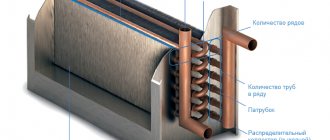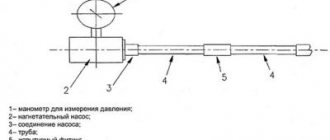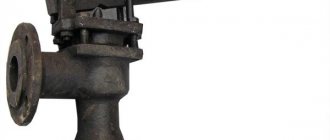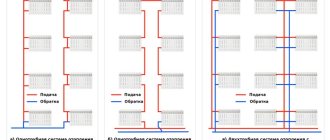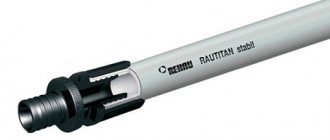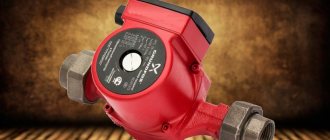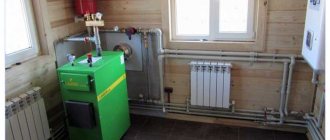Pros and cons of aluminum radiators
The popularity of aluminum batteries is explained by the following advantages of the products:
- Light weight. The weight of one section does not exceed 2 kg.
- Cheapness. Aluminum is a common metal that is easy to process.
- Easy installation and maintenance. The coating is heat-resistant paint that is easy to clean.
- Excellent decorative characteristics.
- High level of heat transfer. This is facilitated by additional ribs with thin walls. According to this indicator, aluminum radiators are almost 3 times superior to conventional cast iron batteries.
- Compact sizes.
- Fast response to temperature switching due to the low thermal “inertia” of aluminum.
Weaknesses of aluminum radiators:
- Very sensitive to the composition of the coolant (hardness, mineralization). Poor water quality often causes equipment failure. Therefore, deciding which antifreeze is best for a radiator must be taken seriously.
- Tendency to corrosion. Design, installation and repair must be carried out very carefully.
- Working pressure restrictions.
- High probability of formation of air pockets due to the chemical activity of the metal with salts dissolved in water
The choice of coolant for aluminum radiators must be done very carefully.
Liquid sealing compounds
In the process of repairing heating devices, compositions for external use are most often used. However, a situation may arise where these products are not suitable for repair work. For example, for hidden leaks, putty is not a solution to the problem; this also applies to hard-to-reach places between radiator sections.
Repairing damage with a liquid composition involves adding it to the coolant and then filling the system. As it circulates through heating appliances, the mixture will fill and neutralize small leaks. The sealing process proceeds as follows: the composition fills the damaged cavity with a slight protrusion outward. Here, when combined with air, the product polymerizes and hardens.
Liquid sealants are presented in several categories on the modern market; their difference lies in the possibility of use in certain conditions.
There are several categories of sealant for radiators:
- Compositions used in coolant systems can be water or antifreeze.
- Compositions that can be used in solid fuel and gas boilers.
- Compositions used for heating pipes.
Each category is used to solve a specific problem, so you should not use one of the listed compounds to fix various leaks. In this case, it is better to use a universal heating liquid sealant. However, practical application has shown that a composition of a narrow direction copes better with solving a specific problem, an analogue of a universal purpose.
In addition, it is important to understand that sealant can cause a blockage in the heating system, and not eliminate the malfunction. Therefore, there is no need to use a sealing agent without certain knowledge and experience working with such compounds.
Types of sealants
Based on their composition, sealants are divided into three types:
- Acrylics are unstable and do not tolerate temperature changes well.
- Polyurethane - characterized by elasticity, good adhesion to metal surfaces, resistance to corrosion and high temperatures.
- Silicone is the most common type of sealant due to its versatility. Moreover, this product retains moisture resistance and elasticity in a fairly wide range of temperature conditions.
- Liquid polymer - used in heating systems specifically to eliminate leaks. They are a liquid that polymerizes upon contact with air.
Below we will take a closer look at the most common types of sealants.
Universal silicone
The most common today is a universal heat-resistant sealant, which is most often used to seal joints. This composition has all the necessary qualities.
In particular, among its properties the following points can be highlighted:
- Good strength;
- The composition is quite liquid and fluid, thanks to which it is able to penetrate even the narrowest crevices;
- Good elasticity.
It must be said that this sealant is used not only for heating systems, but is also used for other household purposes, as well as in industry.
Polyurethane sealant
Polyurethane
A distinctive feature of these compounds is durability and resistance to aggressive environments, as well as mechanical stress. In addition, the advantages include the cost-effectiveness of the composition.
It should be noted that polyurethane sealants come in one- and two-component types. The former take longer to harden, however, their price is lower. It must be said that despite a lot of positive qualities, polyurethane compounds are less common in everyday life than silicone ones, as they are more expensive.
Liquid sealant
Liquid polymer
All of the above compounds are intended for external application to the radiator or processing of threaded connections. But, in some cases, it is impossible to seal a leak from the outside, for example, if it is difficult to detect the damaged area. Then a polymer liquid sealant comes to the rescue.
The principle of its operation is based on the fact that it is poured into the system along with the coolant. In the area where there is a leak, the composition begins to interact with air and polymerize. Thus, clots of the composition seal the gap.
It should be noted that there are several types of liquid sealants:
- For systems operating on water.
- For systems running on antifreeze.
- For sealing metal surfaces.
- For plastic pipes.
Thus, before purchasing the composition, you should read the information contained in the instructions on the package.
Applying sealant to a threaded connection
Types of sealants for heating systems
The choice of sealant is determined not only by the material of the pipes, but also by the type of coolant used and the presence of a heat exchanger. If you choose the wrong product, pipes can become clogged anywhere in the heating system. Various substances can be used as a coolant, and the sealant should not react or be destroyed by contact with them. Based on this criterion, agents are divided into those that can come into contact:
- with water (regular, softened with complexons or magnetized);
- with antifreeze;
- with oils;
- with gas or steam.
A separate line includes sealant for cold water pipes, which is also applied to the threads of faucets and is used to seal joints. The consistency of sealants can be fluid or paste-like. Pipe sealant can also be classified according to its physical properties:
- Drying compounds. As they polymerize, they become completely dry. If the application and drying technology has been violated, the products may shrink and quickly crack.
- Non-drying compounds. Ideal for removing small leaks and sealing threads, although they can be squeezed out at joints under pressure.
Among the popular brands of sealants are Aquastop 2100, BCG, Block Seal 100. Based on their composition, the products are divided into several groups, which are described below.
Oligomer based
Depending on the functional group used in production, such products are divided into polysulfide and polysiloxane. Sealants made from polysulfide oligomers are used much more often for heating systems. They have a unique set of properties: oil resistance, gasoline resistance, gas impermeability, weather resistance, and the ability to operate for a long time in different temperature ranges.
Acrylic
Most acrylic products are not suitable for repairing CO in a private house or apartment. Only some brands are able to withstand temperature changes and boast heat resistance. For example, anaerobic sealants are suitable for sealing pipes and radiators - a type of acrylic compositions that, when released into an airless environment, fill the entire closed volume (crack, chip) and form a homogeneous polymer mass.
Such products can withstand high temperatures, they are very durable and elastic. Seams and joints can subsequently be cleaned with acidic and alkaline substances, since sealants are sufficiently resistant to chemicals. And yet they have one drawback: dismantling the structure will be very difficult, since it becomes monolithic.
Thiokols
Such materials can be used at temperatures of -20...+40 degrees, that is, they are not heat-resistant. Therefore, they are used only in construction for sealing interpanel joints, double-glazed windows, plumbing equipment and are not used for repairing CO.
Silicone
Such funds are considered universal and most in demand. Most silicone sealants are high-temperature and therefore suitable for work in CO environments. They can be liquid or paste-like, the latter having thixotropic properties (do not flow after application). The technical characteristics of silicone compounds are as follows:
- possibility of operation at -60…+300 degrees;
- penetration even into the smallest cracks and depressions;
- adhesion to any surfaces;
- hardening at room temperature;
- resistance to moisture and aggressive chemicals;
- elasticity;
- environmental Safety;
- strength;
- durability.
When purchasing silicone sealant, you need to pay attention to its specific type. The products are neutral and acidic, and the latter can cause corrosion of metals, so they are not suitable for metal pipes.
Polyurethane
Polyurethane-based products are produced in one- and two-component forms. The first ones are inexpensive, but they dry much longer. The latter, after reacting with the hardener, quickly undergo polymerization, resulting in the creation of a strong, elastic connection. Polyurethane compounds are suitable for all types of materials, including metals; they do not provoke corrosion; on the contrary, they protect parts from damage. Sealants are durable, resistant to aggressive chemicals and mechanical stress, and are characterized by low consumption.
Liquid sealant for heating system
Liquid sealant has to be used where there are hidden leaks and there is no access to the place where the defect appears. The material is poured into the damaged pipe along with the coolant. In the area of the crack, the sealant inevitably comes into contact with air and begins to polymerize, sealing the defect. Among the liquid options there are those that work in water, antifreeze, and are suitable for metal or plastic pipes.
Steps to eliminate a leak with liquid sealant
Before you start sealing possible leaks in the heating system, you need to make sure that the expansion tank is in good condition.
The procedure for using liquid sealants to repair your home heating system can seem quite complicated. In some cases, clots of sealing fluid cause partial blockage and impede the movement of the coolant. Therefore, in order not to cause damage to the heating equipment due to your inexperience, it is better to invite a specialist. In any case, you need to study the instructions for using a specific type of sealant for radiators and strictly follow them.
Having decided to use a liquid sealant to fix a problem in the heating system, you need to make sure that:
- the reason for the pressure drop is precisely the leakage of coolant, and is not related to a malfunction of the expansion tank;
- the selected type of sealant for heating systems corresponds to the type of coolant in the system;
- The sealant is suitable for this heating boiler.
German liquid sealant BCG-24 is used to eliminate leaks in heating systems
When using liquid sealant for pipes and radiators, it is important to maintain the correct concentration. On average, its values range from 1:50 to 1:100, but it is advisable to determine the concentration more accurately, since the effectiveness of eliminating leaks can be affected by factors such as:
- coolant leak rate (up to 30 liters per day or more);
- the total volume of water in a given heating system.
If the volume does not exceed 80 liters, 1 liter of sealant will be enough to pour into the heating system. But how can we more accurately calculate the volume of water in the system? You need to calculate how many meters of pipes and what diameter were laid in the house, and then enter this data into one of the online calculators. To the resulting volume of pipelines, you must also add the passport characteristics of the volumes of all radiators and the boiler.
Preparing the heating system
- Dismantle or cut off all filters with taps so that they do not become clogged with a viscous solution of sealant for heating systems;
- Unscrew the Mayevsky valve from one radiator (the first one in the direction of coolant flow) and connect a pump to it (the “Baby” type);
- Start the heating system and let it warm up for an hour to a temperature of 50–60°C at a pressure of at least 1 bar;
- Open all taps on pipelines and radiators to allow sealant to flow freely through them;
- Remove air from the entire system, including the radiators and circulation pump.
Preparing the sealant
- You can also pour liquid sealant into the heating system using a hand pump for pressure testing.
Drain about 10 liters of hot water from the system into a large bucket, use most of it to prepare a sealant solution, and leave a few liters for subsequent flushing of the pump;
- Shake the canister (bottle) with sealant for radiators and heating pipes, then pour its contents into a bucket;
- Rinse the canister thoroughly with hot water so that all remaining sediment gets into the solution being prepared.
Solutions of sealants for heating systems must be prepared immediately before use so that the liquid does not come into contact with atmospheric air for too long.
Pouring sealant
Liquid sealant for heating systems must have time to mix with the coolant before it reaches the boiler, so it is more advisable to pour it into the supply:
- Introduce liquid sealant solution into the system using a pump;
- Pump the remaining hot water through the pump so that absolutely all of the sealant sediment gets into the system;
- Bleed the air from the system again;
- Raise the pressure to 1.2–1.5 bar and maintain the system operating cycle for 7–8 hours at a temperature of 45–60°C. This period is needed for the sealant to completely dissolve in the coolant.
Fixing leaks in the heating system
So, how to fix a leak in the heating system, why does it appear and how can you avoid it? A leak in the system is one of the most common problems in the heating system. It can be neutralized in different ways, and the choice of the appropriate one will depend on the size of the fistula that appears and its location.
As a rule, leakage occurs due to a small hole that appears at the junction of pipes, at the junction of the pipeline with the battery, or in a gap between sections of the radiator. Each of these problems requires special attention. In the event that water literally gushes out of the pipe, then you must immediately call the emergency service, and wrap the damaged area with a blanket.
This is done in order to simplify the approach to the battery for cleaning water that has flowed from the pipe.
What to consider
The heating system of a dacha uses many elements, connections, valves, and adapters. It must be taken into account that ethylene glycol-based antifreeze is a more viscous, viscous substance than water, and all connections and adapters must be more tight and thorough.
Antifreeze can heat up to 170 degrees. In this case, it begins to decompose, which will negatively affect the entire autonomous heating system of the dacha. To do this, the system must provide constant, continuous circulation of antifreeze. If used correctly, antifreeze will last 10 seasons, then it should be replaced.
What types of sealants are there?
All sealants for metal seams on automobile body parts can be divided into two categories - by composition and by application method. The method of application largely determines not only the ease of use, but also whether the product belongs to the professional class.
Division of sealants by composition
The mentioned products can be divided into the following five groups - acrylic, anaerobic, silicone, polyurethane, bitumen. We will describe them in the given order.
Acrylic compounds
They are based on polymer compositions. Such sealants have good adhesion, but their elasticity can be described as average. Accordingly, under strong mechanical loads and/or vibration, there is a risk that they will simply delaminate on their own and lose their properties. Accordingly, they are best used on rough surfaces (most seams are like this) and on stable mechanical components. Their strength is quite good. Acrylic sealants can be either varnished or painted.
Anaerobic sealants
Their peculiarity is that in their non-polymerized (not frozen) form they are a liquid. Accordingly, they can be poured into the smallest cracks and grooves. Their polymerization begins the moment their contact with oxygen (atmospheric air) ceases. Typically, anaerobic agents are used to seal welds in small areas or work in stages. The advantages of these compositions lie in the great strength of the resulting protective stain and its high protective properties. However, its elasticity is low. In addition, working with anaerobic sealant is not always convenient due to the fact that it spreads over an uneven surface.
How to use liquid sealant
For general information, you can consider the process of pouring sealant into a radiator. It is important to follow certain instructions here:
- The system should be shut off and the coolant drained.
- Then you need to dismantle the damaged heating device.
- Pour some hot water into the bucket, about 5 liters.
- Add a concentrated sealing compound to this water and mix well, trying to achieve a uniform consistency.
- The prepared solution is poured into the heating device using a purge pump or funnel.
- If a pump was used during the filling process, then it is necessary to additionally prepare several liters of hot water in order to subsequently rinse the parts of the pump in contact with the polymer composition.
- Next, close the top and bottom plugs on one side of the radiator, and leave these holes open on the other side. The prepared sealing compound is poured into one of these holes.
- The heating device is turned, trying to deliver the sealant to the damaged area.
It is very important to use the solution immediately after preparation, since during the polymerization process, which begins after some time, a dense film forms on the surface.
You can see the process of filling the damaged area with sealant for the heating system after 3 days.
After this, the radiator must be rinsed with hot water. In this case, it is recommended to supply water under pressure so that pieces of the polymer composition that do not stick to the internal walls of the heating device are removed from the radiator.
Use of solid fuel boilers
When deciding how to heat a private house without gas, you may prefer a solid fuel boiler. This heating option has become especially popular in European countries. This type of solid fuel units can provide economical heating, as well as ease of operation. Such devices operate not only on wood, but also on pellets, coal, and peat. Heat will be supplied through the pipeline thanks to water, which acts as a coolant. This heating method allows you to maintain the required temperature inside the premises for a long time, all this is ensured thanks to a sufficiently long burning of fuel in just one load.
How to use sealant to fix a leak?
It is not always possible to repair a heating system using only external means (hidden wiring, heated floors).
In such a case, a universal heat-resistant liquid sealant for heating pipes is poured into the system. In cases where eliminating an emergency situation requires immediate action, and the required brand of sealant is not available, you can use sealant of those brands that are intended for automobile radiators.
Preparing for work
The sealant for heating boilers is selected taking into account the type of the latter and the coolant used. An error in selection can cause blockage of CO pipes in arbitrary places.
Modern liquid brands of sealants for the intended purpose are usually divided into three groups (according to conditions of use):
- for working with CO, the coolant in which is either water or antifreeze;
- for sealing CO (water supply) pipes;
- The heating boiler runs on solid fuel or gas.
The best solution today is considered to be the German liquid sealant for the heating system produced by BCG. Eliminates leaks and does not have a negative impact on the boiler and central heating units installed in the system.
It is important to determine the required concentration of the binder that is added to the coolant. This largely determines the quality of stopping the leak that has arisen. If up to 80 liters of the total coolant volume leaks from the system during the day, then it is enough to add 1 liter of sealant.
The total volume of house CO is calculated as the sum of the volumes of pipelines (pipe length per diameter), batteries and boiler (from the technical passport).
It can be made simpler. Drain the coolant into a single container(s) of known volume.
High-temperature sealant for heating boilers and heating systems in general is added to the system for more than one year, and allows leaks to be eliminated during this period, preventing a drop in pressure in the CO. But only in pipes or radiators. If the malfunction occurs in the expansion tank, the mentioned method will not help.
Setting up CO for filling
All (IMPORTANT!) air is vented.
Because, otherwise, the sealant, under the influence of the air remaining in the system, will begin to polymerize in any places, which can lead to the formation of blood clots in the CO pipes. All valves in the system should be opened, which will allow the sealant to circulate freely and enter all working areas of the CO. In the first radiator (along the path of movement of the sealant), you should completely turn off the Mayevsky valve and install a pump in this place, which pumps the sealant into the system. Afterwards, you should start the heating system and warm it up to a temperature of 60° (this will take about an hour to an hour and a half, in a private house). In this case, the pressure in the system should be at 1.5 bar.
Before starting the mentioned work, all installed filters are covered or removed, because sealant that gets into them will completely disable them.
Preparatory work before using sealant
The selection of a sealing agent for heating systems is carried out taking into account the type of the latter and the thermal fluid used. If you make the wrong choice, this can lead to pipe clogging in random areas.
It was already mentioned above in the article that the market currently offers three options for liquid sealants, based on the conditions of use. This needs to be taken into account.
It is worth deciding on the required concentration of the product added to the coolant. The quality of sealing of the resulting leak largely depends on this. If the system loses up to 80 liters of the total volume of coolant per day, then adding one liter of sealant is enough.
The total volume of the home heating system is calculated by adding the volumes of pipeline networks (pipe length per diameter), radiators and boiler (from the technical data sheet).
Another method can be used. Drain the coolant into one container of a specific volume.
Let's move on to setting up the heating system for filling.
All the air must be vented! Otherwise, the sealing agent will polymerize upon contact with air, which will lead to accumulations in the heating pipes.
All taps present in the network should be opened, this will allow the product to circulate freely and remain in all working areas of the heating system. In the first standing radiator (in the direction of circulation of the product), it is worth turning off the Mayevsky valve completely and installing a pump in this place, which releases the sealant into the system.
After this, you need to start the heating and warm it up to 60° C. This will take about an hour, an hour and a half (in a country house). The pressure in the system must be at 1.5 bar.
Before starting all the above work, all installed filters are covered or removed, because the sealing agent that gets into them will completely damage them.
Preparatory activities
Before applying the sealant, the threads are cleaned and degreased.
Preparatory procedures prior to eliminating a malfunction or leak are discussed using the example of liquid structures. Before using them, you will need to clarify the required concentration of the composition added to the hot coolant circulating through the pipes. When determining this parameter, it is assumed that for every 80 liters of media, one liter of sealing agent is sufficient. Its total volume is calculated by adding these indicators for the entire pipeline network - the consumption of sealant for heating batteries and boiler elements. The latest data is taken from the technical data sheet, which allows us to take into account all possible options for their practical use.
Preparatory measures in the case of dry compounds are reduced to thoroughly cleaning the sealing area.
The main advantages of polypropylene products
Among the advantages of polypropylene structures, one cannot fail to highlight the following:
- high strength and tightness;
- excellent soundproofing qualities;
- high elasticity allows the material to stretch up to 7% of its own volume without compromising its functionality;
- resistance to high temperatures;
- ease and convenience during installation.
Sealants with MS polymers
A recently introduced type of sealant, which, due to its excellent properties, is quickly gaining popularity. They combine the qualities of silicones and polyurethanes, reliably protecting against leakage, forming elastic and reliable connections.
VS polymers - excellent qualities for the bathroom and other wet areas
Properties and scope
The main advantage of sealants based on MS polymers is that in addition to the properties of the sealant, they also have high adhesive ability, which is why their polymers are also called adhesive-sealants. They have the following properties:
- Excellent adhesion to all building materials without the need for primers.
- Solvent-free, safe and virtually odorless.
- They dry quickly and harden even at sub-zero temperatures (only more slowly).
- When dry, they do not harden and remain elastic (elasticity range 25%).
- After drying, you can paint.
- They do not crack or change color when exposed to the sun.
- Waterproof, can be used in fresh and salt water.
- When applied, they do not spread; a neat seam is easily formed on vertical, horizontal, and inclined surfaces.
Excellent properties. There are also disadvantages. The first is the high price, but it is justified, since the seam does not crack or leak for a long time. Second, after some time the surface of the white sealant may turn yellow. This does not affect the quality of the seam, but it does not look nice. You can remove yellowness by wiping the seam with purified gasoline. The third disadvantage is that after hardening, the composition can only be removed mechanically. No solvents have any effect on it.
Manufacturers and prices
MS sealants are available from almost every major manufacturer, and they are also available with various additives that impart special characteristics, so you can choose exactly according to the situation and for a specific type of work.
| Name | Color | Special properties | Formation of a surface film | Release form | Price |
| Bisin MS Polymer (adhesive sealant) | white/transparent | Glass, mirrors, plastics, brick, natural stone, concrete, wood, iron and many other metals. | 15 min at +20°C | Tube for pistol (280 ml) | 490-600 rub. |
| BOSTIK MS 2750 | White black | Metal, wood, glass, polystyrene foam, etc. | 30 min at +20°C | Tube for pistol (280 ml) | 400-450 rub. |
| BOSTIK SuperFix | White gray | Suitable for use underwater, in swimming pools and in areas with high humidity | about 15 minutes | Tube for pistol (280 ml) | 400-550 rub. |
| TECFIX MS 441 | transparent | Resistant to seawater, chlorine, mold and fungi | 10 min at +23°C | Aluminum film sleeve (400 ml) | 670-980 rub. |
| 1000 USOS | white, transparent, grey, blue, green, tiles, black, brown | For bathrooms and kitchens with anti-mould effect | 15 min at +20°C | Tube for pistol (280 ml) | 340 rub. |
| SOUDALSEAL High Tack | White black | For sanitary facilities and kitchens – resists the formation of fungus | 10 min at +20°C | Tube for pistol (280 ml) | 400 rub |
| SOUDASEAL 240 FC | White, black, gray, brown | For sanitary facilities and kitchens, fast polymerization | 10 min at +20°C | Tube for pistol (280 ml) | 370 rub. |
| SOUDASEAL FIX ALL High Tack | White black | For sanitary areas, super strong initial hold | 10 min at +20°C | Tube for pistol (280 ml) | 460 rub. |
Despite the fact that this type of sealant has appeared recently, the range is solid, since the combination of high adhesive ability and sealant properties is very convenient and the product is in demand.
The main advantage of MS sealants is their elasticity after drying, tolerance of prolonged direct contact with water, and resistance to the growth of fungi and bacteria. Therefore, this type of sealant is used to seal the joint between a bathtub or shower stall and a wall. In the case of a shower cabin, it is also good because it does not slip when applied vertically.
Another positive point is that most formulations have a paste-like consistency that goes on smoothly and does not bubble. After application prior to initial curing (film formation), the applied sealant can be easily leveled to give it the desired shape.
Types of sealant
Method of applying acrylic sealant to a threaded connection
Domestic manufacturers offer a huge range of sealing compounds that have their own characteristics, advantages and disadvantages. The correct choice of the most suitable name is possible only after familiarizing yourself with each of them.
Acrylic
Heating sealant from the group of acrylic oligomers is a simple mixture of special polymers. It is suitable for sealing heating pipelines, but is very sensitive to extreme heat and frost: in the first case it cracks, in the second it hardens and crumbles. Therefore, these compounds can only be used for interior work. Despite the fact that acrylic sealants belong to the group of moisture-resistant sealants, their adhesive properties deteriorate with constant contact with water. They are used only for a limited range of work related to sealing cracks and sealing seams in steel and polypropylene pipes.
Thiokols
Thiokol sealant is used in a wide temperature range from -50 to +1300 degrees.
Polysulfide or thiokol compounds are among the most durable of all known types of sealants. The following components are used in their manufacture:
- base;
- heat-resistant hardening pastes;
- additives that accelerate vulcanization.
The thiokol mixture is prepared immediately before applying it to the protected area; the prepared portion must be used within 2 hours.
The advantages of thiokol sealants include:
- elasticity of structure;
- resistance to chemicals, UV, and fuels and lubricants;
- possibility of use in a wide temperature range (from -50 to +1300 degrees);
- good adhesion to steel structures.
Disadvantages: toxicity and high cost of the material, as well as the need to prepare it in small portions.
Silicone
The most common universal sealant option is silicone.
Silicone sealants are among the most popular of all compounds offered on the market. With their help, it is possible to seal joints of any complexity, as well as eliminate any detected leaks without any problems. They can be used at temperature fluctuations from 32 to 62 degrees.
Silicone-based sealants have everything necessary for high-quality sealing: strength, elasticity and the ability to penetrate hard-to-reach areas. When purchasing, it is important to carefully study the composition of the sealant you are purchasing. The acids contained in some of them are very active and can lead to the destruction of the compound.
Polyurethane
Polyurethane sealant is used in industrial facilities to increase the service life of joints.
This type of sealant, along with the polysulfide variety, also represents a group of oligomers that are widespread in construction. The features of polyurethane compositions include resistance to external influences, as well as long service life. They are available in two versions: one- and two-component. The first samples are cheaper, but take longer to harden. In addition, they are characterized by increased elasticity, good adhesion, resistance to high heat and corrosion. Due to the high cost, this type of sealant is practically not used for domestic purposes.
Liquid
Liquid-type sealants are used where there is no access to the damaged area or leakage area. The principle of its operation is based on the fact that the composition is poured into the cavities of the pipes along with the coolant. On a damaged section of the pipeline, it reacts with oxygen and seals the gap as a result of polymerization. The following types of liquid structures are distinguished:
- used in aquatic environments;
- used in systems filled with antifreeze;
- used for sealing metal or plastic pipes.
There are also anaerobic heating sealants or polymer gels used to seal threads.
Effectiveness of sealants against leaks
Sealants are good connectors for sealing leaks in pipes. Experienced engineers claim that if the sealing rules are followed, it is possible to seal cracks with sealant in 90% of cases. However, the use of the product must be justified from an economic and engineering point of view. For example, if you know the location of the crack and have access to it, then it is recommended to repair it by welding.
Another example: a leak occurred due to the formation of a large hole in the system - in this case, the use of sealant is inappropriate, since it only seals small cracks.
Liquid sealants and anaerobic sealants for heating systems, heat exchangers, boilers
A leak in the heating system is one of the most common problems that you may encounter during operation. To eliminate such a malfunction, special reagents are used. Main properties of the sealing liquid:
- It is a moisture-resistant reagent;
- The product does not lose technical characteristics when exposed to high temperatures;
- Withstands mechanical loads.
There are the following types of reagents for sealing leaks:
- Reagents for water pipes.
- Liquid for pipes with antifreeze or water coolant.
- Product for boilers powered by gas or solid fuel.
- Reagents for heating systems (boilers, heat exchangers).
offers to buy reagents for sealing leaks at a competitive price. We offer high quality products, including products from industry leading manufacturer HeatGuardex. This is a professional product for eliminating leaks in open and closed heating systems. Main features and advantages of HeatGuardex reagents:
- Effectively seals leaks inside the heating circuit;
- Suitable for eliminating leaks caused by the formation of microcracks in closed heating systems;
- Used as a sealant in case of leakage caused by loss of pressure in sealed systems;
- Prevents the formation of new cracks and crevices in the heating system;
- The reagent allows you to eliminate hidden leaks in the heating system, sewerage system, and water supply system.
Sealer is an ideal tool for eliminating leaks in closed and open heating systems. In contrast to the common method of eliminating leaks by applying clamps, harnesses, etc. The sealant eliminates leaks by self-application on the inner surface of pipelines and connections. For each reagent presented in our electronic catalog, there is a detailed description. You can also always get informative advice from our specialists by calling our contact number. If you want to buy reagents for sealing leaks, please contact. Cooperation with our organization means:
- Optimal cost of the products offered;
- Reagents from leading manufacturers;
- Guarantee of the quality of the goods sold;
- A wide range of products designed for various types of heating systems.
Fill
Approximately a bucket of heated coolant is poured into a separate clean container. In the other - another half bucket (for future washing). The product is worth chatting and pouring into a bucket. Make sure that the sealant does not come into contact with air for a long time. It needs to be quickly pumped into the heating system.
Again the air is removed from the networks.
The sealant circulates through the heating circuits for several hours. The process of sealing gaps and leaks will be completed in four days. On the fifth day, you need to test the system under high pressure.
And remember, heating system sealant is definitely worth using to prevent leaks. And even though its cost will seem quite high to many. Hidden reconstruction of heating pipes is both a convenience and, at the same time, a certain risk, for which you sometimes have to pay.
How to fix leaks from pipelines
When eliminating pipeline leaks, the following materials and tools are used:
- clamps;
- rubber tubes;
- wire;
- cold welding;
- pipe bandage.
An appropriate algorithm is used to eliminate pipeline leaks.
The most important thing when performing repair work is to eliminate the leak (for more details: “How to eliminate a leaking heating pipe if it is leaking”). First, you need to use rubber to block the hole that appears on the pipe. Having applied rubber to the damaged area, it must be fixed using clamps or wire, and one of the clamps should be located directly above the hole, and the other two secure the edges of the rubber patch. You can also use a special pipe repair bandage, which can be purchased at your local plumbing store. Structurally, such a bandage is a piece of thick rubber, which is clamped onto the pipe with a device similar to a clamp. The bandage is fixed around the entire perimeter of the pipe and secured with bolts, thereby sealing the threaded connections of heating systems.
If a leak occurs at the thread where the pipeline connects to a fitting or elbow, you need to tape a piece of rubber as tightly as possible to the leak site. In this case, one clamp is fixed to the connecting section, and the other directly to the pipe.
If this operation does not eliminate the leak, then you need to use a factory bandage. The rubber from such a kit can be replaced with a piece of tube rubber so that there is no difference in diameter.
Cold welding is often used to eliminate leaks. This method is quite reliable and effective, since it uses a sealant for the heating system of the house (read more: “The heating battery is leaking, what to do, how to fix the leak in a short time”). In order for the material to perform its function well, it must be kneaded until the resulting mass becomes sticky and pliable. When applying cold welding to a pipe, it is necessary to press it firmly and constantly smooth it out. The material needs to be held for about 20 minutes, and for complete hardening it takes about 3 hours. Whatever method is used for repairs, after the end of the cold season, all repaired sections of the heating system must be removed and replaced.
The diameter of the heating pipes is 25 or. Calculation methods
How to calculate the diameter of heating pipes? There are several methods:
- According to special tables. However, their use still requires preliminary calculations: the power of the heating system, the speed of movement of the coolant, as well as heat loss along the main line.
- By thermal power.
- According to the resistance coefficient.
What you need to know to calculate
To carry out the calculation you will need the following data:
- Heat demand (thermal power) of the entire house and each room separately;
- The total power of the heating devices used (boiler and radiators).
- Thermal load on individual sections of the circuit.
- The total heat loss of the house and each room separately during the coldest winter period.
- Resistance value. It is determined by the wiring diagram, the length of the line, the number and shape of bends, connections, and turns.
- The total volume of coolant loaded into the heating main.
- Flow speed.
- Circulation pump power (for forced heating).
- Line pressure.
Calculation of pipe cross-sections for heating systems with forced air circulation:
Calculation procedure
- Calculation of required thermal power.
- Determination of the circulation rate of the carrier in the heating system.
- Calculation of heating circuit resistance.
- Calculation of the required pipeline cross-section.
- Calculation of the optimal diameter of the heating collector (if necessary).
Calculation of system thermal power
Method 1. The simplest way to calculate thermal power is based on the established standard of 100 watts per 1 m² of room. Those. with a house area of 180 m², the power of the heating circuit will be 18,000 watts or 18 kW (180 × 100 = 18,000).
Method 2. Below is a formula that allows you to adjust the data taking into account the power reserve in case of severe frosts:
However, these methods are characterized by a number of errors, because does not take into account the range of factors influencing heat loss:
- ceiling height, which can vary in the range from 2 to 4 or more meters, which means that the volume of heated rooms, even with the same area, will not be constant.
- the quality of insulation of the house facade and the percentage of heat loss through external walls, doors and windows, floor and roof;
thermal conductivity of double-glazed windows and materials from which the house is built.
Climatic conditions of the regions.
Method 3: The method presented below takes into account all the necessary factors.
- The volume of the entire house or each room separately is calculated using the formula:
V = h×S,
Where:
- V – Volume of the heated room.
- h – Ceiling height.
- S – Area of the heated room.
Classification of high-temperature compounds
The characteristics of sealants depend on the base of the thermal insulating paste. For the treatment of fireplaces and stoves, compositions based on silicate and silicone are suitable. The first group is heat-resistant sealants that can withstand direct contact with flame, the second group is heat-resistant pastes. Their operating temperature is significantly lower than refractory compounds.
Each type of sealant has its own characteristics and priority areas of use.
Silicate – heat-resistant mixtures
Sealing paste based on sodium silicate. Externally, the material looks like a viscous black mixture. After hardening, an inelastic layer is formed on the surface.
Due to the formation of a rigid seam, it is better to use such sealants in ovens that have already had time to shrink, as well as in devices where the likelihood of vibration loads is reduced
If this requirement is neglected, there is a risk of cracking of the insulating seam.
Technical characteristics of silicate compositions:
- permissible temperature indicators: short-term – 1400-1500°C, long-term – up to 1300°C;
- hardening time – 15 minutes;
- maximum seam thickness – 15 mm;
- release form: plastic tubes;
- linear deformation without destruction of the frozen mass – 7%;
- application conditions – temperature within 1-40°C, the exact value depends on the manufacturer.
Silicate compounds have good adhesive properties. To increase the reliability of the coupling, it is advisable to pre-treat a metal, concrete or brick base with an abrasive.
Not all heat-resistant pastes are fire-resistant sealants and are able to retain their properties when exposed to flame. The packaging must bear the appropriate inscription
Heat-resistant paste is most effective when sealing joints of fixed elements with a similar expansion coefficient.
When is it advisable to use silicate sealant:
- sealing cracks in combustion chambers and other surfaces in contact with fire, as well as high-temperature gases;
- sealing cracks formed between steel and cast iron elements of stove appliances and brickwork;
- sealing of chimneys that discharge high-temperature gases, for example: solid fuel boilers and sauna stoves;
- processing of casting installation areas;
- eliminating leaks in heating boilers.
Heat-resistant pastes are used when assembling a sandwich chimney - the joining surfaces are treated with sealant.
Silicone – heat-resistant seals
Silicone-based insulating paste has a brownish-reddish color. The shade is due to the addition of iron oxide to the product. Heat-resistant silicone sealants with different operating temperatures are available for sale, the range of values being 170-300°C.
High temperature oven compounds are often confused with automotive sealants. However, they are not interchangeable. Distinctive features of pastes for heating devices: absence of a sharp acidic odor and packaging in tubes, not small tubes
Silicone sealants retain elasticity after drying - the seams are not afraid of deformation loads and shrinkage of ovens. An additional plus is excellent water resistance, which allows the composition to be used to seal cracks in areas where the roof and chimney come into contact. Silicone paste cannot be painted.
Technical characteristics of heat-resistant seals:
- operating temperature range – within +300°С;
- packaging – tubes, packed in 310 ml;
- Drying period – about 20 minutes;
- application on a cold base at above-zero air temperature, but not more than +40°C;
- resistance to UV rays;
- sealing cracks with a depth of 6 mm.
The cost of silicone thermosealant is often lower than its silicate counterpart. However, due to the insufficient temperature threshold, its use is limited to the treatment of not too hot surfaces.
Scope of use:
- sealing brick chimneys in street areas;
- sealing the joints of the exhaust duct and roofing material;
- treatment of smoke exhaust ducts made of metal, brick and sandwich panels, provided that boilers with an efficiency of over 90% are used - the temperature of the exhaust gases does not exceed +150°C;
- treatment of blind cracks on brick external surfaces of stoves and fireplaces.
The high-temperature composition is also suitable for sealing threaded connections when installing heating circuits.
Selecting a sealant
Maximum compaction when assembling sewer, heating or water supply systems can only be achieved by using a correctly selected sealant.
Two types of sealants are used to assemble pipelines:
Silicone sealants
Silicone sealant is based on silicone rubber, to which are added:
- compositions to increase adhesion;
- compositions to increase strength;
- impurities to accelerate vulcanization.
Silicone based sealing compound
The advantages of silicone-based sealants are:
ease of use. The sealing material is applied to the surface of the pipe using a special gun or squeezed out by hand (small packages of material);
Device for easy application of sealant
- durability. Thanks to such qualities as elasticity, excellent adhesion, resistance to deformation, water resistance and heat resistance, the service life of silicone sealant is 15 - 20 years;
- wide scope of application. Silicone-based sealants can be used in the assembly of pipelines from various types of pipes. The sealing composition is suitable for the construction of internal or external pipelines, since the sealant is resistant to aggressive environments and direct exposure to sunlight.
Among the disadvantages of the sealing material are:
- seams treated with sealant cannot be coated with paint, since its composition negatively affects the sealant, reducing the service life;
- It is not recommended to use sealant when constructing a pipeline in cold weather, since low temperatures significantly reduce the vulcanization (hardening) period of the composition;
- The sealant should not be used on pipes larger than 4 inches (100 mm) in diameter.
Silicone sealants, depending on the chemical composition, can be:
- acidic. This type of sealing compound is not suitable for sealing pipes made of non-ferrous metals, since a chemical reaction occurs between the materials;
- neutral.
Acrylic sealants
To seal water supply pipes, heating pipes, and so on, a separate type of acrylic sealant is most often used - anaerobic.
Anaerobic sealant is used to seal threaded connections. When it comes into contact with metal, the sealant hardens. The final polymerization of the substance, which imparts strength to the joint, is carried out after assembling the pipeline system assembly without access to air.
Sealing compound for threaded connections
The advantages of anaerobic sealant for heating systems, sewerage, water supply and so on are:
ease of use. The sealing compound is applied to the thread (flange connection) without the use of additional devices;
- resistance to vibration, which allows you to extend the service life of the threaded connection by 4 - 5 years;
- resistance to high temperatures and high pressure;
- no need to use additional sealing materials;
- additional protection of the metal surface of the thread from corrosion.
However, this type of sealant also has its disadvantages, which include:
- Can only be used on metal surfaces. For plastic pipes connected into a socket, this composition is not suitable;
- difficult to dismantle. If a specific section of the pipeline needs to be replaced, preheating will be required to separate the pipes and remove the sealant;
- the possibility of using sealant for pipes whose diameter does not exceed 8 cm;
- high price.
Depending on the strength of the resulting connection, all anaerobic sealants are divided into three groups:
- standard strength. The composition is used in the manufacture of pipelines with low pressure and not subject to vibration;
- medium strength. This sealant is used for the construction of a pipeline with average operating parameters;
- increased strength. Used to seal joints that are under high pressure and do not require constant dismantling.
When choosing an anaerobic sealant, it is also worth considering the composition of the mixture and the diameter of the pipes, which may vary depending on the product line or manufacturer.
Applying a mask
To achieve a visible result, before applying the mask, you need to steam your facial skin well and open the pores. To do this, hold your cleansed face over a steam bath prepared with a series of steam baths for about ten minutes.
- Wipe your face dry and immediately apply the prepared black mask to it. Be careful that the mixture does not cover your eyebrows, because when it hardens, the mask will pull out the hairs along with the blackheads.
- The effective effect is about fifteen minutes, after which wet the mask a little with warm water using a spray, grab it by the lower edges and slowly pull the film up with your hands.
- Apply moisturizer to your face and avoid going outside for one hour.
The frequency of use of this black mask directly depends on the condition of your skin. If you use it for preventive purposes, once a week is enough. In the case when the facial skin is neglected and a lot of blackheads and pimples appear on it, it is recommended to make masks twice a week. The duration of treatment is from two to three months.
The availability of components and knowledge of how to make a mask for blackheads at home will help bring problematic facial skin into order. The main thing is that when purchasing ingredients at the pharmacy, be sure to check that they are all fresh, as the effectiveness of the mask depends on this. There are no contraindications identified, so feel free to start cleansing blackheads at home.
There are plenty of recipes for black masks. You can switch to a different “composition” after each course, or you can always stick to one. But dermatologists and cosmetologists recommend changing skincare products every six months, since the skin develops immunity to them and over time the effect of masks will become weaker.
Conclusions and useful video on the topic
During the process of sealing a sewer system, many questions arise. We offer video materials that will help you cope with difficulties and complete all the work yourself.
Instructions for sealing sewer pipes using silicone sealant:
We offer video instructions on how to properly mix epoxy resin and hardener:
Do-it-yourself video tutorial on sealing the socket of a cast-iron external sewer:
Detailed instructions for sealing the socket of sewer pipes when switching from cast iron to plastic:
Whatever type of sealant for sewer pipes you choose, you need to carefully prepare the surfaces and perform the work efficiently. There should be no cracks or fistulas on the pipes. Before sealing, they are cleaned, repaired, and degreased.
When working, you should strictly adhere to the technology, and after finishing it, wait the allotted time until the composition hardens. Only after this the system can be operated normally.
Do you have experience sealing sewer pipes? Please share information with our readers and suggest your method of solving the issue. You can leave comments in the form below.
Sealing leaks at joints
You can seal leaks at the connection points of the heating circuit in the following ways:
- Install a classic crimp clamp, first eliminating any unevenness with additional rubber bands.
- Seal the leak at the joint by wrapping it with several layers of soaked elastic fabric. As impregnation, you can use waterproof adhesives or ordinary nitro enamel.
- Minor damage can be repaired using baking soda and instant glue. Lightly moistened baking soda is rubbed into the gap or fistula until it fills the entire space. Super glue is poured on top. The substances instantly react with each other, forming a strong plug.
We recommend that you read: How to make a high-quality boiler for a bath with your own hands?
It is convenient, just in case, to have a ready-made kit at home for local repairs such as Siloplast. The kit includes an acrylic fistula pad and a tape impregnated with a special compound for sealing the leak. It is enough to wrap it around the pipe and moisten it with water. For such repairs it is not necessary to drain the water from the heating system.
Note! High-quality repair of threaded connections requires mandatory dismantling and diagnostics.
Results
Discussions on the topic of whether it is possible to pour antifreeze into aluminum radiators brought very specific answers. Responsibility for choosing a coolant lies entirely with the owners of the household. When considering various liquid options, one should keep in mind one more feature of systems filled with antifreeze coolant. If the operating temperature regularly exceeds the limit of +70ᶷ degrees, it is better to refrain from using antifreeze solutions, because because they have a very high expansion due to the alcohol content. This is fraught with pipeline ruptures and damage to heating devices.


